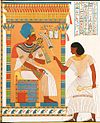Reporter (Ancient Egypt)
| |||
| wḥmw The Reporter in hieroglyphs | |||
|---|---|---|---|
The reporter (also herald) (Ancient Egyptian: wḥm.w) was an Ancient Egyptian title. The literal meaning of wḥmw translates to 'one who repeats'. This is generally rendered as 'reporter', 'messenger', 'herald' or similar.[1] The title first appeared in the Old Kingdom as an honorific of a high official, and later became an administrative function during the Middle Kingdom.[2] In the New Kingdom the role developed an oracular aspect.[3]
Usage[edit]
Administration[edit]


Faulkner and Gardiner translates wḥmw as 'herald, reporter', suggesting that officials bearing this title in the Middle Kingdom were involved in the dissemination of information within the governmental administration.[4] The title has been attributed to household officials, officials assigned to specific missions, as well as ordinary high-ranking local officials of the Middle Kingdom.[5] Sobekemsaf was a notable official of the Thirteenth Dynasty with the title reporter of Thebes.
Religious[edit]
The usage of the title within the religious framework relates to the belief of an intermediary between deities and man.[6] During the New Kingdom, statues were erected in the forecourts of temples in order to intercede for the public who were prohibited from entering the temple proper.[7][8] These 'intermediary statues' were meant to report requests and petitions to the local gods.[9] A known statue of Amenhotep, son of Hapu (who was posthumously deified), dates back to the reign of Amenhotep III, and reads:
Perform an offering which the king gives for (me)
and libate for me from what you have.
I am a herald (wḥmw) whom the king appointed
in order to hear the petitions of the humble,
in order to bring forward matters of the Two Lands.— Urk.IV, 1833, 17–19
On another statue, Amenhotep calls himself the 'herald of the god Amun'.[10]
The Apis bull was worshiped as the herald of the gods Ptah, Osiris and Atum.[11][12]

References[edit]
- ^ Simmance, Eleanor Beth (2014). Amenhotep son of Hapu: self-presentation through statues and their texts in pursuit of semi-divine intermediary status (m_rs thesis). University of Birmingham. p. 45.
- ^ Amer, Islam Amer (2017-01-01). "Function of the Herald WHmw in the Ancient Egypt". Jguaa, 18.
- ^ Colonna, Angelo (2021-10-21). Religious Practice and Cultural Construction of Animal Worship in Egypt from the Early Dynastic to the New Kingdom: Ritual Forms, Material Display, Historical Development. Archaeopress Publishing Ltd. ISBN 978-1-78969-822-0.
- ^ Schnare, Laverne (1981). EGYPTIAN PROVINCIAL ADMINISTRATION IN THE EARLY MIDDLE KINGDOM. p. 134.
- ^ Ilin-Tomich, Alexander (2015-10-01). "Theban Administration in the Late Middle Kingdom". Zeitschrift für Ägyptische Sprache und Altertumskunde. 142 (2): 123–124. doi:10.1515/zaes-2015-0012. ISSN 2196-713X. S2CID 163269203.
- ^ Morenz, 1960, p. 109
- ^ Frood, Elizabeth (2019-01-01). "When statues speak about themselves". Pages 3–20 in Statues in context: Production, meaning and (Re)uses. Edited by Aurélia Masson-Berghoff. British Museum Publications on Egypt and Sudan 10: 7–8.
- ^ "Communication with the Divine in Ancient Egypt: Hearing Deities, Intermediary Statues and Sistrophores". Docslib. Retrieved 2024-02-15.
- ^ Colonna, Angelo (2021-10-21). Religious Practice and Cultural Construction of Animal Worship in Egypt from the Early Dynastic to the New Kingdom: Ritual Forms, Material Display, Historical Development. Archaeopress Publishing Ltd. ISBN 978-1-78969-822-0.
- ^ "statue | British Museum". www.britishmuseum.org. Retrieved 2024-02-16.
- ^ Ringgren, Helmer (1982), Phillips, Anthony; Knibb, Michael; Coggins, Richard (eds.), "Prophecy in the ancient Near East", Israel's Prophetic Tradition: Essays in Honour of Peter R. Ackroyd, Cambridge: Cambridge University Press, pp. 1–11, ISBN 978-0-521-31886-0, retrieved 2024-02-13
- ^ Voss, M. Heerma van; Hoens; Mussies, Gerard; Plas; Velde (2018-11-13). Studies in Egyptian Religion, Dedicated to Professor Jan Zandee. BRILL. ISBN 978-90-04-37862-9.

